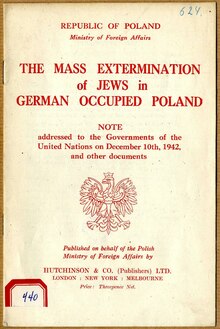The Mass Extermination of Jews in German Occupied Poland
 | |
| Author | Edward Bernard Raczyński, Stanisław Mikołajczyk, others |
|---|---|
| Country | United Kingdom |
| Language | English |
| Subject | The Holocaust in Poland |
| Published | 1943[1][2] |
| Publisher | Polish government-in-exile, Hutchinson |
| Media type | brochure |
| Pages | 16 |
| Text | The Mass Extermination of Jews in German Occupied Poland at Wikisource |
The Mass Extermination of Jews in German Occupied Poland was a brochure published by the Polish government-in-exile in 1943 to disseminate the text of Raczyński's Note of 10 December 1942.[3][4] It was the first official information to the Western general public about the Holocaust in German-occupied Poland.[3][4][5]: 200
History
The brochure contained reports and documents about
The brochure was published in 1943[1][2] and contained also the text of the Joint Declaration by Members of the United Nations of 17 December 1942, and an excerpt of a statement by Deputy Prime Minister Stanisław Mikołajczyk of 27 November 1942. The motivation for publishing the report was to draw attention to the Final Solution and deter the Germans from pursuing it further.[9]
Reception
Though the document contained extensive information on the persecution and murder of Jews in Poland, its effect was limited because many people outside
Modern commentators have raised questions as to why the report was not published sooner, because the Polish government-in-exile had been kept apprised of the events in Poland by the underground state, the
In 2013 a copy of the book sold at a Paris auction for 21,000 euros.[11]
See also
- Karski's reports
- The Polish White Book
- Pilecki's Report
References
- ^ ISBN 9780399116926.
The Mass Extermination of Jews in German-Occupied Poland. London: Hutchinson, 1943.
- ^ a b "Live auction 2607: Fine Printed Books and Manuscripts Including Americana". Archived from the original on 16 March 2021.
- ^ a b Republic of Poland (1943). The Mass Extermination of Jews in German Occupied Poland. London, New York, Melbourne: Hutchinson (on behalf of the Polish Ministry of Foreign Affairs).
- ^ a b c Wroński, Stanisław (1971). Polacy i Żydzi 1939–1945, (eng. "Poles and Jews" 1939–1945) (in Polish). Warsaw: Książka i Wiedza.
- ^ ISBN 9781469619576.
- ISBN 9781107014268.
- ^ ISBN 9780415318716.
- ^ "Poland". Yad Vashem. Retrieved 8 August 2018.
By the end of 1942 a large majority of Poland's Jews had been killed.
- ISBN 9783631598283.
- ^ Tzur, Nissan. "The man who told the world about the Holocaust – and wasn't believed". The first news. Retrieved 7 August 2018.
- ^ ""Raport Karskiego" sprzedany za 21 tys. euro". TVN24.pl. Retrieved 17 June 2019.
